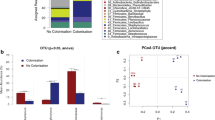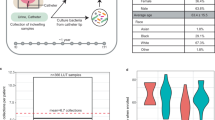Abstract
Microorganisms play important roles in intravascular catheter (IVC)-related infections, which are the most serious complications in children with IVCs, leading to increased hospitalisation, intensive care admissions, extensive antibiotic treatment and mortality. A greater understanding of bacterial communities is needed in order to improve the management of infections. We describe here the systematic culture-independent evaluation of IVC bacteriology in IVC biofilms. Twenty-four IVC samples (six peripherally inserted central catheters, eight central venous catheters and ten arterial catheters) were collected from 24 paediatric patients aged 0 to 14 years old. Barcoded amplicon libraries produced from genes coding 16S rRNA and roll-plate culture methods were used to determine the microbial composition of these samples. From a total of 1,043,406 high-quality sequence reads, eight microbial phyla and 136 diverse microbial genera were detected, separated into 12,224 operational taxonomic units (OTUs). Three phyla (Actinobacteria, Firmicutes and Proteobacteria) predominate the microorganism on the IVC surfaces, with Firmicutes representing nearly half of the OTUs found. Among the Firmicutes, Staphylococcus (15.0 % of 16S rRNA reads), Streptococcus (9.6 %) and Bacillus (6.1 %) were the most common. Community composition did not appear to be affected by patients’ age, gender, antibiotic treatment or IVC type. Differences in IVC microbiota were more likely associated with events arising from catheter dwell time, rather than the type of IVC used.






Similar content being viewed by others
References
Perez E, Williams M, Jacob JT, Reyes MD, Chernetsky Tejedor S, Steinberg JP, Rowe L, Ganakammal SR, Changayil S, Weil MR, Donlan RM (2014) Microbial biofilms on needleless connectors for central venous catheters: comparison of standard and silver-coated devices collected from patients in an acute care hospital. J Clin Microbiol 52(3):823–831
Zhang L, Gowardman J, Rickard CM (2011) Impact of microbial attachment on intravascular catheter-related infections. Int J Antimicrob Agents 38(1):9–15
Cecinati V, Brescia L, Tagliaferri L, Giordano P, Esposito S (2012) Catheter-related infections in pediatric patients with cancer. Eur J Clin Microbiol Infect Dis 31(11):2869–2877
Halton KA, Cook D, Paterson DL, Safdar N, Graves N (2010) Cost-effectiveness of a central venous catheter care bundle. PLoS One 5(9). pii: e12815
Mermel LA, Allon M, Bouza E, Craven DE, Flynn P, O’Grady NP, Raad II, Rijnders BJ, Sherertz RJ, Warren DK (2009) Clinical practice guidelines for the diagnosis and management of intravascular catheter-related infection: 2009 Update by the Infectious Diseases Society of America. Clin Infect Dis 49(1):1–45
Timsit JF (2007) Diagnosis and prevention of catheter-related infections. Curr Opin Crit Care 13(5):563–571
Maki DG, Weise CE, Sarafin HW (1977) A semiquantitative culture method for identifying intravenous-catheter-related infection. N Engl J Med 296:1305–1309
Murray PR, Masur H (2012) Current approaches to the diagnosis of bacterial and fungal bloodstream infections in the intensive care unit. Crit Care Med 40(12):3277–3282
Grice EA, Kong HH, Renaud G, Young AC; NISC Comparative Sequencing Program, Bouffard GG, Blakesley RW, Wolfsberg TG, Turner ML, Segre JA (2008) A diversity profile of the human skin microbiota. Genome Res 18(7):1043–1050
Zhang L, Morrison M, Nimmo GR, Sriprakash KS, Mondot S, Gowardman JR, George N, Marsh N, Rickard CM (2013) Molecular investigation of bacterial communities on the inner and outer surfaces of peripheral venous catheters. Eur J Clin Microbiol Infect Dis 32(8):1083–1090
Zhang L, Gowardman J, Morrison M, Krause L, Playford EG, Rickard CM (2014) Molecular investigation of bacterial communities on intravascular catheters: no longer just Staphylococcus. Eur J Clin Microbiol Infect Dis 33(7):1189–1198
Huse SM, Huber JA, Morrison HG, Sogin ML, Welch DM (2007) Accuracy and quality of massively parallel DNA pyrosequencing. Genome Biol 8(7):R143
Cantacessi C, Giacomin P, Croese J, Zakrzewski M, Sotillo J, McCann L, Nolan MJ, Mitreva M, Krause L, Loukas A (2014) Impact of experimental hookworm infection on the human gut microbiota. J Infect Dis 210(9):1431–1434
Arnell K, Cesarini K, Lagerqvist-Widh A, Wester T, Sjölin J (2008) Cerebrospinal fluid shunt infections in children over a 13-year period: anaerobic cultures and comparison of clinical signs of infection with Propionibacterium acnes and with other bacteria. J Neurosurg Pediatr 1(5):366–372
Miller SE, Maragakis LL (2012) Central line-associated bloodstream infection prevention. Curr Opin Infect Dis 25(4):412–422
Ramos I, Pérez R, Reinoso M, Torio R, Fdz-Polanco M (2014) Microaerobic digestion of sewage sludge on an industrial-pilot scale: the efficiency of biogas desulphurisation under different configurations and the impact of O2 on the microbial communities. Bioresour Technol 164:338–346
Larsen MK, Thomsen TR, Moser C, Høiby N, Nielsen PH (2008) Use of cultivation-dependent and -independent techniques to assess contamination of central venous catheters: a pilot study. BMC Clin Pathol 8:10
Raad I, Chaftari AM (2014) Advances in prevention and management of central line-associated bloodstream infections in patients with cancer. Clin Infect Dis 59:S340–S343
Stevens TP, Schulman J (2012) Evidence-based approach to preventing central line-associated bloodstream infection in the NICU. Acta Paediatr Suppl 101(464):11–16
Acknowledgements
We acknowledge Tara Williams from Lady Cilento Children’s Hospital for her assistance with the IVC sample collection. LZ is supported by the Griffith University Bridging Fellowship. The research was funded by an Australian government National Health and Medical Research Council project grant (grant number: APP1008428).
Author information
Authors and Affiliations
Corresponding author
Ethics declarations
Conflict of interest
All authors declare no conflicts of interest relevant to this article.
Rights and permissions
About this article
Cite this article
Zhang, L., Marsh, N., Long, D. et al. Microbial diversity on intravascular catheters from paediatric patients. Eur J Clin Microbiol Infect Dis 34, 2463–2470 (2015). https://doi.org/10.1007/s10096-015-2504-9
Received:
Accepted:
Published:
Issue Date:
DOI: https://doi.org/10.1007/s10096-015-2504-9




